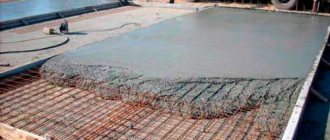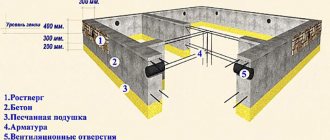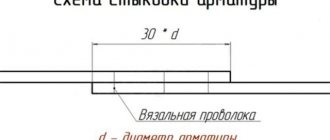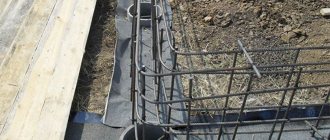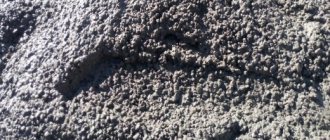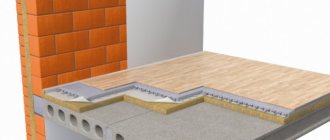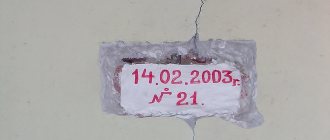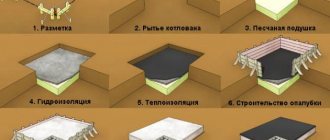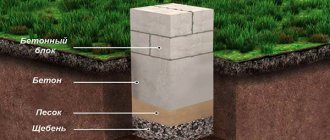The start of the construction season is just around the corner, but building a house is a very expensive process and people are looking for ways to save money. Cement is one of the main building materials, and its quality significantly affects the final result of the work performed, be it pouring a foundation, screeding or masonry. Unfortunately, when choosing bagged Portland cement, consumers rarely think about the possible risks of purchasing a low-quality product. However, it is low-quality cement that can cause a burst foundation, cracked screed or efflorescence on the wall.
The advice in our article will help you minimize the risk of purchasing low-quality products.
How does the brand of mortar depend on the brand of cement material?
Fillers used for concrete give the solution certain properties and additional qualities.
In the classic version, concrete is composed of crushed stone, cement and sand, when mixing which a certain amount of water is added. The quality of the mixture being prepared depends on the binding component.
Concrete solutions are differentiated by the load forces they can withstand. To determine it, laboratory tests of samples are necessary, according to which the mixture is labeled according to the composition and type of binder. For different types of buildings, certain concrete compositions are used, taking into account the required level of strength.
There is no definite answer as to what brand of cement is needed to fill the foundation. The fact is that the quality of the binder is determined by numerous factors.
Most often, builders use M400 or M500 cement. As a rule, cement, sand and crushed stone are taken in a ratio of 1 to 3 to 5. The quality characteristics and brand of cement directly affect the quantity. For example, a higher class is added to the mixture being prepared in a smaller volume.
Types and their application
The binder has many varieties.
Return to contents
Portland cement
Portland cement is a type of cement, a hydraulic binder.
The most common material. Its use is usually associated with construction for various purposes, the production of both heavy and light concrete, cellular concrete structures, materials for thermal insulation, and the highest grades of mortar. Operating conditions are not limited. It must be stored in closed warehouses. Mixing several grades of cement into a single whole is unacceptable.
In turn, to comply with construction requirements for the quality of the cement mixture, Portland cement is divided into subcategories. Their main difference is their inherent properties. Let us consider these cements in detail.
Return to contents
Plasticized
Its production involves grinding the corresponding clinker, which consists of gypsum and a plasticizer, the amount of which should not exceed 0.15-0.25% by weight of the entire solution. This solution corresponds to grades 400 and 500. The main features of this material are:
- increased mobility;
- plasticization, the essence of which is to reduce the amount of water contained in the finished product;
- density;
- resistance to low temperatures;
- waterproofing properties of concrete.
As a rule, it is used for laying road surfaces, airfields and hydraulic structures.
Return to contents
Hydrophobic
It is formed by adding substances with water-repellent properties to clinker. They include:
- fatty acids from synthetic materials;
- petrolatum, susceptible to oxidation;
- asidol;
- Mylonaft and others.
The adsorption of these substances serves as a protective layer for cement at the monomolecular level from moisture. Hydrophobization helps cement avoid corrosion and destruction during the thawing process. Its advantages:
- resistance to sub-zero climatic conditions;
- weakly susceptible to corrosion and moisture;
- Air humidity does not affect shelf life.
It is used in the construction of hydraulic, port, airfield and road structures. In addition, it can be used for cladding building surfaces.
Return to contents
Fast-hardening
The main feature of this cement is based on the hardening process. This property is mentioned in the marking of the mixture with the letter “B”. The strength of the material is achieved by kneading. It is thanks to this quality that the cement mixture becomes popular. In addition, reinforced concrete structures are manufactured without the use of steaming chambers. Most often used to create special concrete.
Return to contents
Sulfate resistant
This Portland cement is characterized by low heat generation, which is ensured due to its high sulfate resistance. Thanks to this, it becomes possible to use concrete obtained from the use of this cement in the construction of structures with high sulfate influence.
Return to contents
White and colored
White Portland cement is formed by using clinker with a low concentration of iron. As for the colored material, it is obtained by adding various pigment substances to their composition, such as ocher, chromium oxide and others. The use of both solutions is typical for decorating buildings.
Return to contents
Expanding cement mortar
This category of cement is a special mixture used for certain types of construction work. Working with concrete involves its shrinkage when drying. In this regard, problems arise during surface finishing, creation and repair of large concrete objects, sealing and insulating reinforced concrete seams from moisture, as well as during other work. It is to resolve these difficulties that expanding cement is used. Its distinguishing feature is the compensation of shrinkage due to an increase in the volume of the mixture in the first stages of concrete work.
The main components of this type of cement mortar are Portland cement or aluminous cement mortar (70% of the total mass), gypsum and other additives. In addition to its tendency to stretch, it has quick-hardening properties due to the presence of gypsum in the mixture. The volume of the mixture increases as the material gains strength. This occurs due to the formation of crystals in cement, the appearance of which is caused by the reaction of the components to moisture. Subsequent crystal growth. and as a result, the cement mortar increases in volume within 3 days. Advantages:
- long service life;
- high compatibility;
- resistance to chemicals and the environment.
Flaws:
- high price;
- use only for certain types of work, namely: treatment of cracks and seams; gluing of reinforced concrete structures;
- finishing of shell coverings.
Return to contents
Alumina solution
Heat-resistant aluminous cement.
This material can be classified as fast-acting and hydraulic type cements. To create it, you need to grind a burnt or fused alumina mixture. In addition, the composition of the mixture includes limestone, lime or alumina rock. The color of the substance may be grey-green, brown or black.
The main advantage of aluminous cements is fire resistance due to fillers such as magnesite, fireclay, and ore.
Typically, its use is associated with industrial structures exposed to high temperatures, water or gas. In case of accidents and repair work, it can also be used as a sealing agent on sea vessels.
Return to contents
Pozzolanic mixture
This concept combines a group of cement mortars that contain mineral substances and which occupy at least 20% of the total mortar mass. It also contains Portland cement and some gypsum. Pozzolanic cement mortar is used for the construction of underwater and underground structures. Distinctive properties:
- corrosion resistance;
- slow hardening;
- resistance to low temperatures.
Return to contents
Slag Portland cement
This is a binder material that is characterized by the ability to harden both in an aqueous environment and in air. It is produced by grinding a mixture of Portland cement clinker, gypsum and granulated blast furnace slag. It is possible to mix pre-crushed components. Slag Portland cement has the following characteristics:
- the presence of slag slows down hardening;
- low strength;
- moderate heat generation during hardening;
- Concrete deformation is significantly less.
All brands of this type of cement are used when making concrete for buildings, regardless of location.
Return to contents
How is cement marked?
Not only the operational life of the structure, but also its tensile and bending strength indicators - those types of loads that the concrete strip experiences most of all - depend on the cement used to fill the foundation base. To know what brand of cement is needed for the foundation of a house, it is recommended to understand its differences.
NOT so long ago, a concrete mixture was prepared on the basis of one of the binding components - PC (Portland cement) or ShPC (slag Portland cement). The main difference was the powder composition and strength characteristics. The grades of cement for the foundation complied with current GOST standards.
In addition to the name, the brand of cement material for constructing foundations and other works contains a designation with numbers that indicate the maximum strength under load until complete destruction.
Now let's see what grades of cement there are, how the marking is applied and what its meaning is.
According to the old designation system, several brands were distinguished:
- M 300 - withstands loads of up to three hundred kilograms per square centimeter of surface;
- M 400 – corresponds to a pressure of 400 kg;
- M 500 - withstands impacts of at least five hundred kilograms per unit of area;
- M 600 - carries a load of six hundred kilograms.
The characteristics given here are not able to give unambiguous advice on what brand of cement to use for constructing the foundation of a house, and what to use when building lighter structures. Naturally, for large structures it is necessary to take material with a greater load. But you can prepare a concrete solution with the required characteristics by changing the amount of cement composition of a lower grade, increasing its quantity.
When determining which cement material is best for the foundation of a house, it is recommended to pay attention to the presence of mineral additives in it and their quantity.
This criterion is present in the labeling of the material, and its presence is indicated by the corresponding letters and numbers D0 or D20. Before making the final choice in cement, it is recommended to clarify how mineral components influence the quality of the binder. For example, D0 does not contain any components, and the solution is of the highest quality. But the brand with the designation D20 contains up to twenty percent of impurities, which reduce not only strength, but also cost. When choosing a cement material, for example, to construct a fence foundation, you can use a powder with a lower strength index, thereby reducing the overall cost of construction work.
When deciding which material is best to use for pouring a strip foundation, you should study the remaining characteristics of the component indicated in the labeling. The most common designations are:
- PL – cement contains plasticizer additives. This type of foundation material is used when the region experiences low temperatures in winter;
- VRC - this abbreviation denotes the moisture resistance of the mixture and the increase in volume during hardening. If you are in doubt which cement is best for a foundation in a swampy area, then you will not find another option;
- B - such material requires less time before final hardening. If you have a choice about what to use for the foundation of a house, when the time frame for work is limited, choose this particular cement material;
- SS – sulfate-resistant cement. It is rarely used by private developers, because its main purpose is considered to be concreting hydraulic structures. When plugging oil and gas wells, plugging cement is used - a mixture of clinker powder, gypsum and other components;
- N – cement with this marking has undergone additional rationing using clinker. This additive ensures high strength of the material;
- BC – “white cement”. A distinctive feature is that it becomes lighter after hardening. It is rarely used, mainly for finishing work.
Marking: old and new
The biggest confusion arises from several varieties of cement brands that are sold on the Russian construction market. Difficulties that buyers encounter are associated with deciphering cement grades, since there are currently three existing GOST standards: two Russian and one European. Moreover, there is no difference between the products, but many do not know this and fall for the tricks of sellers who assure that the “European product” is better.
Old markings
The oldest standard is simple. The grade in it is indicated by the letter “M”, and the tensile strength is indicated by numbers: from 100 to 700. The combination of letters and numbers shows the proportion of additives in cement:
- D0 - without them;
- D5 - no more than 5%;
- D20 - maximum 20%.
If more than 20% of additives were used, then the letter “Ш” is added, indicating that the mixture contains blast furnace slag.
The old (1985) GOST became inconvenient and uninformative due to the greatly expanded range of cement, so an improved one appeared in 2003.
New designations
The name “CEM” appeared on the labeling. It is followed by another letter through the fraction, indicating the subtype of the material - the number of additives:
- A - from 6 to 20%;
- B - from 20 to 35%.
Strength characteristics in the “Novorussian” standard are expressed not in letters and numbers, but in megapascals. To make it clearer, it is better to give the old markings and the new one:
- M100 - 7.5 MPa;
- M200 - 15 MPa;
- M300 - 22.5 MPa;
- M400 - 32.5 MPa;
- M500 - 42.5 MPa;
- M600 - 52.5 MPa.
The last digit of the marking indicates the hardening speed:
- N - normal;
- B - fast (high).
Example: CEM I 42.5N - cement M500, with a standard hardening speed. Now we need to “tell” about the new marking. Cyrillic and Roman numerals indicate:
- CEM I is pure cement with less than 5% additives. For this reason, it has the highest hardening rate: after 24 hours it gains about 50% strength. Its operating strength characteristics are 32.5 MPa.
- CEM II. This mixture contains more additives - 6-35%. Because of them, it hardens more slowly.
- CEM III. Portland slag cement (32.5 MPa) with normal hardening speed.
- CEM IV - pozzolanic cement, contains fly ash (Z), microsilica (M, MK).
- CEM V. This is a composite with additives: fly ash (10-30%), blast furnace slag (10-30%).
For comparison, it is better to give the old and new markings of the same material: PC (M) 400 D0 and CEM I/A 32.5N.
Assessment of the quality of cement raw materials
A low-quality material will not make a good concrete foundation, and you should learn to identify its signs by appearance.
When choosing which cement is best for the foundation of a house, garage or for the foundation of a bathhouse, you should pay attention to a number of indicators:
- date of production - the quality characteristics of cement gradually decrease during storage of the material. If the cement was made six months ago, then it is not recommended to use it for serious objects;
- consistency - ideal powder state - loose, without lumps. This is easy to check - the packaging is touched and turned over;
- packaging material must remain intact and dry. When deciding which cement is better, check the name of the manufacturer and production time. If there is no such information, there is no point in buying the material.
It turns out that it is difficult to choose cement for pouring the foundation. All working conditions of the material, the condition of the soil composition, and the timing of construction should be taken into account.
What to use when building a foundation
We have to remember that the soil composition may differ in certain characteristics. For dry soil, it is better to prepare a solution from cement grade 500 D0, and you will get a mixture of grade M 350.
You can use the help of experienced builders who will tell you which brand of cement is best to use in a particular case, in what proportions to mix, and what sand dispersion to choose.
As a rule, M 400 and PC 400 with a D20 indicator are used in private construction for the construction of a one-story house and utility room. For such foundations, the maximum load is not the main indicator, and cement of this brand is considered an ideal solution that saves money.
M 400 and PC 400 D0 are almost similar in properties to D20, but do not contain impurities. And if you are building a foundation that must be used in a humid environment and in severe frosts, and do not know which cement is better - with or without additives, use “clean” material.
M 500 and PC 500 D20 are good cement for foundations for large industrial and administrative facilities, high-rise residential buildings. For construction in frosty and humid regions, it is better to use PC 500 D0.
Choosing a brand of cement for the foundation of a house
On the building materials market you can buy cement of various brands, where the number corresponds to the dispersion of the material. Also, some factories produce so-called dust cement, which has high binding properties, is used in the construction of drilling rigs, but is produced in limited quantities and is very expensive. The most popular among builders remains Portland cement, which is produced with special additives.
Additives provide the necessary binding characteristics, impart additional properties that ensure frost resistance of the solution, protect concrete from aggressive environments, and improve the rate of hardening.
Foundation mortar.
When purchasing cement, you need to decide on the brand of the product. Cement with a high grade indicates a high rate of hardening of the solution. Also on the packaging there are special indices that indicate a number of other characteristics of cement:
- D0 – pure product, without additives;
- D20 – containing 20% mineral additives;
- N – normalized. The composition contains standardized clinker filler.
- B – fast-hardening. This is a composition that can harden fairly quickly.
- PC – Portland cement.
- BC – white cement. In most cases, this product is used for finishing and facade work.
- PL – plasticized, characterized by high frost resistance.
- GF – hydrophobic. A specific type of material, characterized by high frost resistance, but at the same time does not immediately absorb water.
- SS – sulfate resistant. An excellent solution for the construction of foundations and finishing work in aggressive environments.
- VRC – waterproof. This is a special type of product that expands when hardened and is virtually impermeable to water.
We evaluate the composition of cement raw materials
To check the composition and practical quality of cement, mineral water containing bicarbonate, without gases, is used. Cement powder is mixed with this water until it forms a dough. A flatbread is prepared, thick in the center and thin at the edges. If high-quality material that does not contain additives was used to make cement, the cake hardens in ten to fifteen minutes, and it is quite difficult to destroy it (especially in the center).
At the moment of hardening, the cake heats up and changes color from gray to bluish-green. This effect does not occur with every cement material and depends on the specific manufacturer.
If the cake remains soft for half an hour, the cement does not have good binding qualities; it contains impurities, about which you will not find any information on the packaging material. As follows from the reviews of developers, such material is not suitable for foundations, because it cracks during the hardening process.
Which cement to choose for preparing concrete for the foundation
Depending on the composition and properties, several types of cement are distinguished. But the most popular was and remains Portland cement, which differs not only in its brand (class), but also in the presence of special additives that change the properties of the building material in one direction or another (with their help, the setting of concrete can be slowed down or accelerated, heat dissipation can change, resistance to exposure to an aggressive environment, etc.). What do the letter and numeric indices indicated on bags of cement mean?

